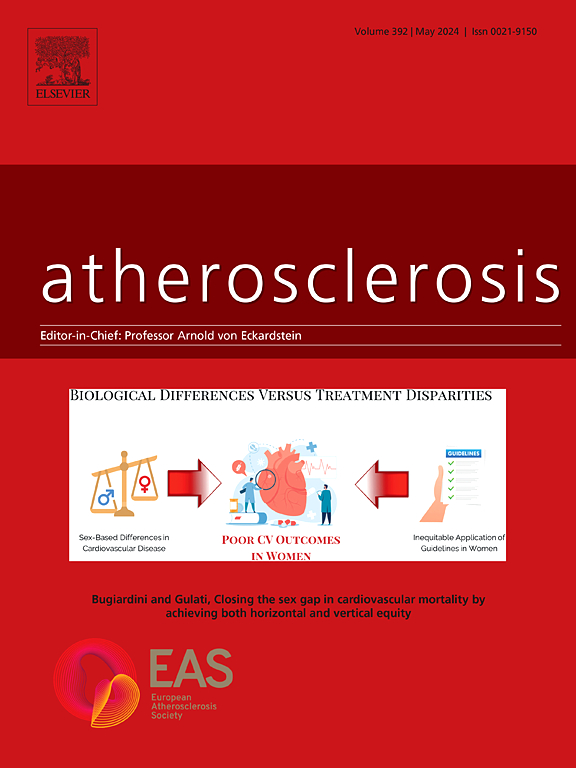Reliability of different formulas for estimating plasma Apolipoprotein B levels in a large cohort of South European individuals
IF 4.9
2区 医学
Q1 CARDIAC & CARDIOVASCULAR SYSTEMS
引用次数: 0
Abstract
Background and aims
Direct measurement of apolipoprotein B (ApoB) is not always standardized and is relatively expensive, making it unavailable in several low-income settings. To address this issue, several formulas have been developed to estimate ApoB levels. Therefore, our study aims to compare the reliability of 23 formulas for estimating ApoB levels in a large cohort of South-European individuals.
Methods
We retrospectively assessed 4.577 clinical records in which ApoB measurements were obtained using the same standardized method. Overall concordance was defined as the proportion of cases where the directly measured ApoB level fell within the same category as the estimated ApoB level, based on ApoB quartiles (<80 mg/dL, 80–94 mg/dL, 95–114 mg/dL, and ≥115 mg/dL). In addition, overall concordance was assessed for different lipoprotein(a) (Lp(a)) and non-high density lipoprotein cholesterol (non-HDL-C) sub-levels. Ordinary least squares linear regression analyses were performed to compare estimated and measured ApoB values. Residual error plots were generated to visualize the difference between each estimation method and the actual ApoB measurements, stratified by Lp(a) and non-HDL-C levels.
Results
Plasma ApoB levels were best predicted by a non-HDL-C based formula and a formula using Friedewald's low-density lipoprotein cholesterol (LDL-C), regardless of ApoB plasma levels. Non-HDL-C levels did not significantly affect the concordance between measured and estimated ApoB across the different formulas, except at low non-HDL-C levels. Similarly, Lp(a) levels did not significantly impact concordance. However, the highest concordance level was 41 %.
Conclusion
Some simple formulas based on low-cost and widely available parameters can estimate ApoB levels independently of ApoB, non-HDL-C, and Lp(a) plasma levels. This approach may be particularly useful for estimating ApoB levels in low-resource settings.

在大量南欧人群中,估算血浆载脂蛋白B水平的不同公式的可靠性
背景和目的载脂蛋白B (ApoB)的直接测量并不总是标准化的,而且相对昂贵,使其在一些低收入环境中无法使用。为了解决这个问题,已经开发了几个公式来估计ApoB水平。因此,我们的研究旨在比较23种估算南欧人群载脂蛋白水平公式的可靠性。方法回顾性分析采用相同标准化方法测定ApoB的4577例临床记录。总体一致性定义为基于ApoB四分位数(80 mg/dL, 80 - 94 mg/dL, 95-114 mg/dL和≥115 mg/dL),直接测量的ApoB水平与估计的ApoB水平处于同一类别的病例比例。此外,评估了不同脂蛋白(a) (Lp(a))和非高密度脂蛋白胆固醇(non-HDL-C)亚水平的总体一致性。用普通最小二乘线性回归分析比较ApoB估计值和实测值。生成残差图,以显示每种估计方法与实际ApoB测量值之间的差异,并按Lp(a)和非hdl - c水平分层。结果无论ApoB水平如何,非hdl - c基础公式和Friedewald's低密度脂蛋白胆固醇(LDL-C)公式最能预测血浆ApoB水平。除了低非hdl - c水平外,非hdl - c水平没有显著影响不同公式中ApoB测量值和估计值之间的一致性。同样,Lp(a)水平对一致性没有显著影响。然而,最高的一致性水平为41%。结论基于低成本和广泛可用参数的简单公式可以独立于ApoB、非hdl -c和Lp(a)血浆水平估算ApoB水平。这种方法对于低资源环境下ApoB水平的估计可能特别有用。
本文章由计算机程序翻译,如有差异,请以英文原文为准。
求助全文
约1分钟内获得全文
求助全文
来源期刊

Atherosclerosis
医学-外周血管病
CiteScore
9.80
自引率
3.80%
发文量
1269
审稿时长
36 days
期刊介绍:
Atherosclerosis has an open access mirror journal Atherosclerosis: X, sharing the same aims and scope, editorial team, submission system and rigorous peer review.
Atherosclerosis brings together, from all sources, papers concerned with investigation on atherosclerosis, its risk factors and clinical manifestations. Atherosclerosis covers basic and translational, clinical and population research approaches to arterial and vascular biology and disease, as well as their risk factors including: disturbances of lipid and lipoprotein metabolism, diabetes and hypertension, thrombosis, and inflammation. The Editors are interested in original or review papers dealing with the pathogenesis, environmental, genetic and epigenetic basis, diagnosis or treatment of atherosclerosis and related diseases as well as their risk factors.
 求助内容:
求助内容: 应助结果提醒方式:
应助结果提醒方式:


